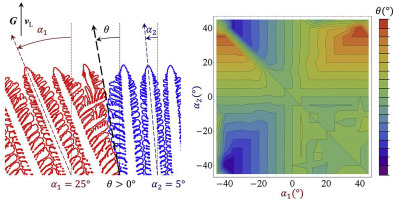当前位置:
X-MOL 学术
›
Acta Mater.
›
论文详情
Our official English website, www.x-mol.net, welcomes your
feedback! (Note: you will need to create a separate account there.)
Growth competition between columnar dendritic grains – Cellular Automaton versus Phase Field modeling
Acta Materialia ( IF 8.3 ) Pub Date : 2018-08-01 , DOI: 10.1016/j.actamat.2018.05.032 A. Pineau , G. Guillemot , D. Tourret , A. Karma , Ch.-A. Gandin
Acta Materialia ( IF 8.3 ) Pub Date : 2018-08-01 , DOI: 10.1016/j.actamat.2018.05.032 A. Pineau , G. Guillemot , D. Tourret , A. Karma , Ch.-A. Gandin

|
Abstract Cellular Automaton (CA) simulations of two-dimensional growth competition among columnar dendritic grains are carried out for a succinonitrile - 0.4 wt% acetone alloy. This is achieved by computing the Grain Boundary (GB) orientation during directional solidification of a bi-crystal in a frozen temperature gradient approximation, each crystal being defined by its own orientation. Comparisons are subsequently conducted with recent Phase Field (PF) results derived under the same conditions as well as with the Geometrical Limit (GL) criterion and the Favorably Orientated Grain (FOG) criterion. The GL criterion is defined mathematically considering infinitely small branching within each grain in directions perpendicular to the main dendrite arms growth directions. The FOG criterion states survival of the grain having the growth direction best aligned with the temperature gradient. The GB orientation is investigated by CA simulations as a function of the cell size, the cell neighborhood and the position used to compute the growth velocity. Results reveal that sufficiently small cells lead to the convergence of the GB orientation towards the GL criterion, while sufficiently large cells lead to the FOG criterion. Within a range of intermediate cell size, excellent agreement is found with a revised version of the FOG criterion (rev-FOG) extracted from PF simulations over a wide range of grain orientations. The cell size needs to be of the order of the maximum step between primary stationary dendrite tips of the two competing grains. The Moore neighborhood provides better results than the von Neumann neighborhood. Noticeable improvement is also observed when computing the growth velocity at the leading dendrite tip positions compared to using the cell center approximation. With computational times several orders of magnitudes lower than PF, the CA method offers a realistic and useful alternative for direct simulations of solidification grain structures in casting processes. This work is also an example of upscaling between models, showing how PF dedicated to model phenomena at the scale of the solid-liquid interface and sidebranching competition can be used to evaluate and calibrate CA developed for large scale simulations.
中文翻译:

柱状树突晶粒之间的生长竞争——元胞自动机与相场建模
摘要 对丁二腈 - 0.4 wt% 丙酮合金进行柱状枝晶之间二维生长竞争的元胞自动机 (CA) 模拟。这是通过在冻结温度梯度近似下双晶定向凝固过程中计算晶界 (GB) 取向来实现的,每个晶体由其自己的取向定义。随后与最近在相同条件下得出的相场 (PF) 结果以及几何极限 (GL) 标准和有利取向晶粒 (FOG) 标准进行比较。GL 标准是在数学上定义的,考虑到每个晶粒内在垂直于主要枝晶臂生长方向的方向上的无限小分支。FOG 标准规定了生长方向与温度梯度最佳一致的晶粒的存活。通过 CA 模拟研究 GB 方向作为细胞大小、细胞邻域和用于计算生长速度的位置的函数。结果表明,足够小的单元导致 GB 方向向 GL 标准收敛,而足够大的单元导致 FOG 标准。在中间单元尺寸的范围内,发现与从 PF 模拟中提取的 FOG 标准 (rev-FOG) 的修订版本在广泛的晶粒方向上具有极好的一致性。单元尺寸需要是两个竞争晶粒的初级静止枝晶尖端之间的最大步长的数量级。摩尔邻域比冯诺依曼邻域提供更好的结果。与使用单元中心近似法相比,在计算主要枝晶尖端位置的生长速度时,也观察到了显着的改进。由于计算时间比 PF 低几个数量级,CA 方法为铸造过程中凝固晶粒结构的直接模拟提供了一种现实且有用的替代方法。这项工作也是模型之间升级的一个例子,展示了如何使用专用于固液界面和侧支竞争规模的模型现象的 PF 来评估和校准为大规模模拟开发的 CA。与使用单元中心近似法相比,在计算主要枝晶尖端位置的生长速度时,也观察到了显着的改进。由于计算时间比 PF 低几个数量级,CA 方法为铸造过程中凝固晶粒结构的直接模拟提供了一种现实且有用的替代方法。这项工作也是模型之间升级的一个例子,展示了如何使用专用于固液界面和侧支竞争规模的模型现象的 PF 来评估和校准为大规模模拟开发的 CA。与使用单元中心近似法相比,在计算主要枝晶尖端位置的生长速度时,也观察到了显着的改进。由于计算时间比 PF 低几个数量级,CA 方法为铸造过程中凝固晶粒结构的直接模拟提供了一种现实且有用的替代方法。这项工作也是模型之间升级的一个例子,展示了如何使用专用于固液界面和侧支竞争规模的模型现象的 PF 来评估和校准为大规模模拟开发的 CA。
更新日期:2018-08-01
中文翻译:

柱状树突晶粒之间的生长竞争——元胞自动机与相场建模
摘要 对丁二腈 - 0.4 wt% 丙酮合金进行柱状枝晶之间二维生长竞争的元胞自动机 (CA) 模拟。这是通过在冻结温度梯度近似下双晶定向凝固过程中计算晶界 (GB) 取向来实现的,每个晶体由其自己的取向定义。随后与最近在相同条件下得出的相场 (PF) 结果以及几何极限 (GL) 标准和有利取向晶粒 (FOG) 标准进行比较。GL 标准是在数学上定义的,考虑到每个晶粒内在垂直于主要枝晶臂生长方向的方向上的无限小分支。FOG 标准规定了生长方向与温度梯度最佳一致的晶粒的存活。通过 CA 模拟研究 GB 方向作为细胞大小、细胞邻域和用于计算生长速度的位置的函数。结果表明,足够小的单元导致 GB 方向向 GL 标准收敛,而足够大的单元导致 FOG 标准。在中间单元尺寸的范围内,发现与从 PF 模拟中提取的 FOG 标准 (rev-FOG) 的修订版本在广泛的晶粒方向上具有极好的一致性。单元尺寸需要是两个竞争晶粒的初级静止枝晶尖端之间的最大步长的数量级。摩尔邻域比冯诺依曼邻域提供更好的结果。与使用单元中心近似法相比,在计算主要枝晶尖端位置的生长速度时,也观察到了显着的改进。由于计算时间比 PF 低几个数量级,CA 方法为铸造过程中凝固晶粒结构的直接模拟提供了一种现实且有用的替代方法。这项工作也是模型之间升级的一个例子,展示了如何使用专用于固液界面和侧支竞争规模的模型现象的 PF 来评估和校准为大规模模拟开发的 CA。与使用单元中心近似法相比,在计算主要枝晶尖端位置的生长速度时,也观察到了显着的改进。由于计算时间比 PF 低几个数量级,CA 方法为铸造过程中凝固晶粒结构的直接模拟提供了一种现实且有用的替代方法。这项工作也是模型之间升级的一个例子,展示了如何使用专用于固液界面和侧支竞争规模的模型现象的 PF 来评估和校准为大规模模拟开发的 CA。与使用单元中心近似法相比,在计算主要枝晶尖端位置的生长速度时,也观察到了显着的改进。由于计算时间比 PF 低几个数量级,CA 方法为铸造过程中凝固晶粒结构的直接模拟提供了一种现实且有用的替代方法。这项工作也是模型之间升级的一个例子,展示了如何使用专用于固液界面和侧支竞争规模的模型现象的 PF 来评估和校准为大规模模拟开发的 CA。











































 京公网安备 11010802027423号
京公网安备 11010802027423号